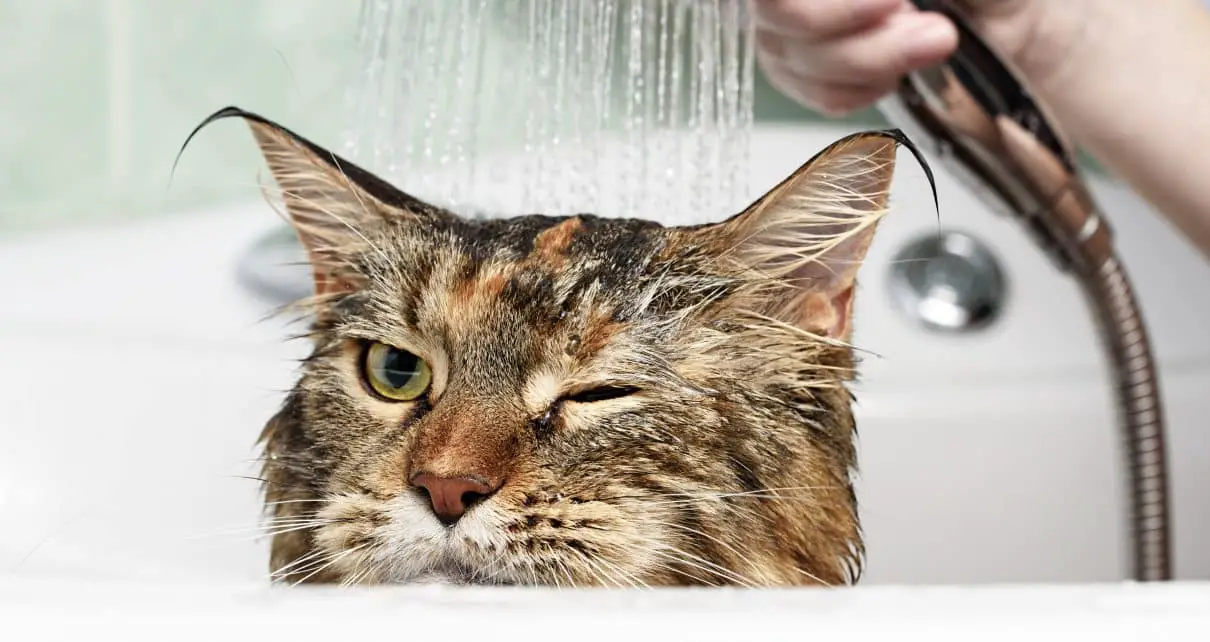Have you ever tried bathing a cat? If so, you probably know the drill.
You run the bath water, corral the cat and put up with her struggles while you work the shampoo in. Then you rinse her off and maybe use the hair dryer to dry her off. Maybe you just release her so she can lick herself dry.
However, is all this effort even necessary
Do Cats Need Baths
Cats are pretty good about washing themselves after eating or doing anything more strenuous than taking a nap. Sometimes they’ll even wake up, wash their paws and go back to sleep.
They’re sticklers for cleanliness, our feline friends. And thanks to their systematic licking and grooming habits, they’re probably cleaner than most of us.
As such, indoor cats usually don’t get dirty enough to require a bath. When they do, it’s usually because they somehow got into something filthy and now they’re tracking dirt all over the place. Which – as all cat owners known – is prone to happen.
Mine somehow got into my tub of flour while I was baking some muffins one time, which pretty much meant white dust all over, including on the cat. That meant I had to put the muffins on hold and give the cat a bath. The tub of flour was a lost cause, but that’s a whole different story.
But even if your cat isn’t covered in flour, there are some times when a cat bath can come in handy.
So…Should I Bathe My Cat
It depends. Not all cats need regular baths but if you’ve got one of the below situations on your hands, a cat bath might be in order…
- Your Cat is Dirty. This one’s obvious. If your cat is covered in mud, dirt, flour or whatever else she got herself into – a cat bath is a good idea. As flexible as your cat may be, there can be hard-to-reach places a bath can help clean up, especially if she’s covered in gunk.
- Your Cat Stinks. Got a smelly cat roaming around your house? It’s time for a cat bath.
- Your Cat is Sticky. Sometimes cats show up from wherever they went with sticky stuff in their fur. A warm bath will help gently loosen it out of their hair, which will be less painful than trying to brush it out.
- Your Cat is Shedding. If your cat is shedding, a bath can get rid of loose fur and dander that you can’t get out by brushing alone.
- Your Cat is Getting Old. Older cats can benefit from being gently bathed every so often to clean areas that they can’t quite reach for a good cleaning anymore.
- Your Cat Goes Outdoors. Baths might benefit outdoor cats even more, especially if you pick a flea shampoo that kills fleas and their eggs.
How Often Should You Bathe a Cat
Cat baths should be a once-in-a-blue-moon kind of event. Cats don’t need to be bathed as often as we do and more importantly – shouldn’t be bathed too often since frequent baths can deplete the natural oils on your cat’s fur and leave her more vulnerable to skin issues. I know you don’t want to deal with a case of kitty dandruff.
There’s no hard and fast rule for how often to bathe a cat, but try not to bathe your cat more than once every two months unless they’re shedding, have fleas or get especially dirty.
If you do decide to bathe your cat more frequently, keep in mind that the experience is usually stressful for the cat (unless you’ve got a cat breed that loves water), so this shouldn’t be done more than necessary.
Can You Use Human Shampoo on Cats
The short answer is no, it’s better not to. Many shampoos designed for humans can irritate a cat’s skin since your cat’s skin has a different pH balance than human skin does, which means that products designed for humans may not be good for cat skin.
To be on the safe side, go with a good shampoo that is formulated specifically for cats.
If you go with a good flea bath, do NOT use anything that is scented like mint or lists mint as an ingredient because mint is toxic for cats. Some botanical formulas such as Natural Chemistry Pet Shampoo may be useful and is very gentle on your cat’s skin.
You should also avoid any shampoo that contains artificial dyes, parabens, sodium laurel sulphate or petrochemicals. If the label on any shampoo is unclear about what it contains, pass it up. Do not underestimate the importance of choosing the right product for the job. There have been cases of a cat’s fur being pink after having a bath.
If you’d rather not cause unnecessary stress for your cat, you can find waterless shampoos as sprays, towel wipes and dry cat shampoo powders. Thankfully, there’s a world of waterless options out there for bath-hating felines.
How to Bathe a Cat (and Survive)
Alright, so you’ve decided that your furry feline friend is due for a bath. Here’s how to bathe a cat without getting killed in the process.
Pre-Cat Bath
Your cat bath pre-game is as important as the actual bath itself. Here are the steps to take before washing your cat for a no-fuss, no-claws cat bath time.
Brush First
Brush out any tangles in your cat’s fur to avoid matting and get rid of any loose fur. Before you brush, though, make sure your cat does not have any bald spots, wounds or bumps that may make brushing painful.
Brushing first also has the additional benefit of helping you spot potential issues. As you brush, watch out for scabs, round scaly patches, redness, inflammation, and hair loss because these might be symptoms of parasites or ringworm. If you notice any of these symptoms, the bath can wait until you’ve visited the veterinarian.
Clip Those Claws
Trimming your cat’s claws before the bath starts is a good thing to do to avoid collateral damage in the form of scratches.
Don’t skip this step – this is for your own good.
Be sure to shine a small flashlight through your cat’s claws before trimming. This helps you see where blood vessels are in your cat’s claws so that you can avoid cutting them by accident while trimming. It’s usually a good idea to do this a few hours before the bath and give him a treat after you’re done trimming as a reward.
Relaxed Cat = Happy Cat
Your cat should be relaxed before starting the bath. Brushing the cat’s fur can help calm him because he associates the feeling with his mother washing him as a kitten.
It also helps to play with your cat for a little bit before the bath to help cut down on the struggling. Turning up some calming cat music before and during the bath is a good idea as well.
The Cat Bath
It’s time for the actual bath. You ready? Here’s the plan.
Prepare the scene
Make sure you close the door before starting the bath to avoid your wet cat escaping into the rest of the house. This is especially important if you have other cats that may get into the bathroom and add to the excitement.
Put a mat or old towel in the bottom of the tub to give your cat some traction and help avoid injury while in the bath. My cat likes to do this absolutely pitiful gig of clawing helplessly at the sides of the bathtub and the mat on the bottom helps him act that scene out more effectively.
Run a few inches of lukewarm water in the bathtub before bringing your cat in. The water does not need to be very deep at this stage.
While you run the water, prepare everything you need for a successful cat bath. Trust us when we say nothing will annoy your cat more than being unwillingly drenched in water while you rummage around for the cat shampoo. So do yourself a favor and have these ready:
- Cat shampoo
- A dry towel or two
- A rubber floor mat or spare towel for the bathtub
- Cotton balls (for your cat’s ears)
- Elbow-length gloves (these are for you)
Protect your cat (and yourself)
If possible, put cotton balls in your cat’s ears. Shampoo and water should not get into your cat’s ears, eyes or mouth. Get your cat wet from the neck down, but try not to get the head or face wet.
If you have an especially feisty cat on your hands, you’ll want to get a pair of elbow-length rubber gloves to help your arms survive this ordeal.
Wash your cat
Shampoo your cat with a light massaging motion, which helps to get your cat clean while soothing him. Rinse with the water from the tub or a bucket of clean water. Don’t use the faucet or shower hose because the cascade of water can frighten your cat.
You can wash your cat’s face by gently wiping it with a wet washcloth. At all times, be sure to watch your cat for signs of distress. It’s acceptable to take a break if he hisses, yowls, breaths heavily or cries so he doesn’t dread the next bath.
And again, if the cat fights the bath too much, you might have better luck with a dry shampoo or treated cloths that can remove dirt without distressing your cat.
The After bath
Now that you’ve finished the bath with no great harm to yourself or the cat, it’s time to dry off. I usually just cocoon my cat in a large, absorbent towel and give him treats for being a good kitty so he is more likely to associate bathtime with a positive experience.
Short haired cats usually like to air dry next to a heat source such as a space heater, which is okay as long as it’s not too drafty in that area. A hair dryer on low power can also help the cat dry faster but skip the blow dryer if the bath was already stressful for your cat. Long haired cats may need an extra brushing to detangle fur while they dry.
Once your cat is dry, he probably feels good about being clean and you can turn him loose. He may groom himself afterward and ignore you for a while, which is perfectly okay. This is a way for the cat to calm down after the unpleasantness of having been bathed.
By the way, if you simply cannot bear the thought of your cat hating you – you can always take your kitty to a professional groomer. It’s pricier than a DIY cat bath, of course, but for $20 to $50 bucks, you can also get your cat’s ears cleaned and their nails clipped…and have someone else your cats can hold accountable for the entire experience.



